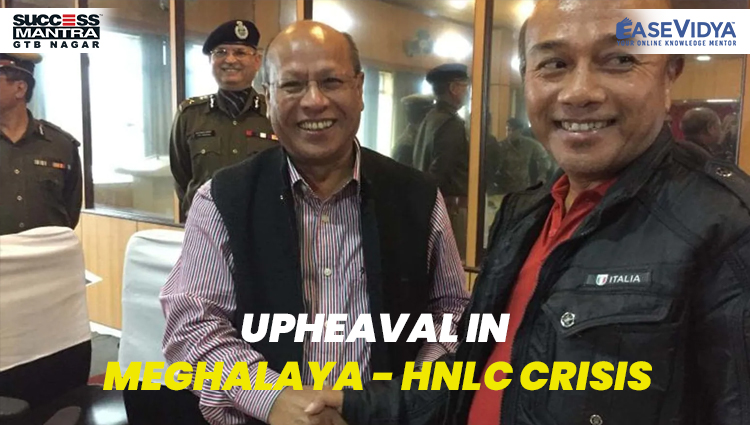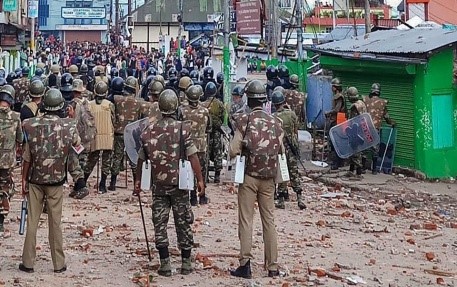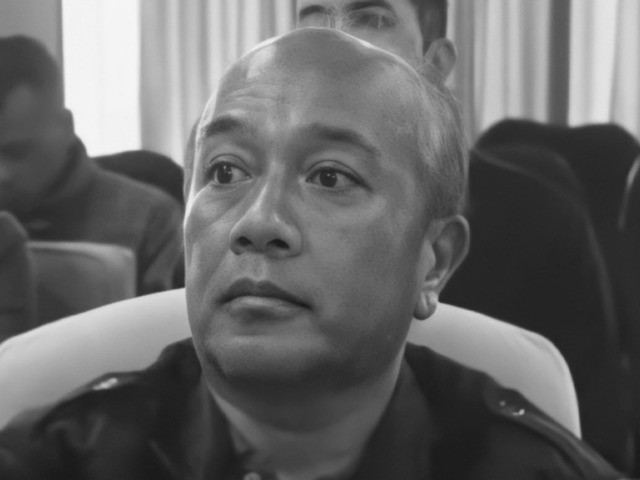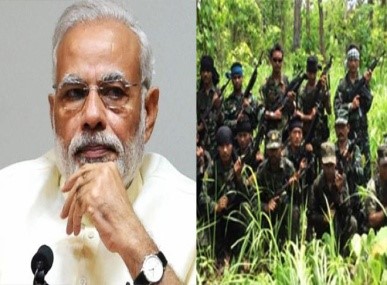
UPHEAVAL IN MEGHALAYA HNLC CRISIS
UPHEAVAL IN MEGHALAYA - HNLC CRISIS

After the death of Cherishterfield Thangkhiew, a former militant of the outlawed Hynniewtrep National Liberation Council (HNLC), during a police operation, Shillong witnessed arson, stone pelting, and vandalism on August 15, 2021, and has been put under curfew till August 18, 2021. Meghalaya’s Home Minister Lahkmen Rymbui on August 15, 2021, resigned and called for a judicial probe to uncover the truth behind the killing of Thangkhiew of the HNLC during a police operation on August 13. Amid the unrest, the Meghalaya government has suspended internet services for 72 hours in four districts, East Khasi Hills, West Khasi Hills, South-West Khasi Hills, and Ri-Bhoi district beginning from 6 pm on August 15, 2021.
Important Update regarding the recent IED explosion in Laitumkhrah: An operation was launched in the early hours of 13th August to arrest one Cherishterfield Thangkhiew and his associates, who attacked the Police team in an attempt to escape.
WHO WAS CHERISHTERFIELD THANGKHIEW?

Thangkhiew was the founding General Secretary of the separatist Hynniewtrep National Liberation Council (HNLC). Thangkhiew had entered militancy in 1987 and was the co-founder of the first prominent separatist militant tribal organization Hynniewtrep Achik Liberation Council (HALC) in Meghalaya. He surrendered to the government in October 2018. Thangkhiew was gunned down at his residence in Shillong during a police encounter on August 13. The encounter was reportedly carried out by the police team of East Khasi Hills and East Jaintia Hills. The Police team in their statement said that Thangkhiew came upon the team with a knife to which the police team in their defense fired a single shot at him. Meghalaya police further stated that they had strong incriminating evidence of Thangkhiew’s involvement in the IED blasts in the past two months.
BACKGROUND OF THE ISSUE
Meghalaya shares a border with Bangladesh and has seen decades of migration from the neighbouring country as well as from other parts of India - Bengal, Punjab and Bihar. This has sparked anxieties of indigenous communities who feared becoming a "minority in their own homeland" because of the influx of "outsiders". It was a culmination of these "anti-outsider sentiments" that led to the formation of Meghalaya's first militant group, the Hynniewtrep Achik Liberation Council (HALP), in 1992. Hynniewtrep represented the Khasi and Jaintia communities and Achik represented the Garo community. HALC was later divided and HNLC came into being that represented the Khasi and Jaintia communities and the Achik Matgrik Liberation Army that represented the Garo community. The Achik Matgrik Liberation Army was later replaced by the Achik National Volunteers Council (ANVC). HNLC claimed to represent only the interest of Khasi Communities, whereas, the Achik Matgrik Liberation Army demanded a separate state for the Garo community.
Present Status of militancy in Meghalaya: The ANVC since 2004 has been under an extended ceasefire agreement with the government while the HNLC has been trying to talk peace with the government but on a conditional basis. Over the last several years, militancy in Meghalaya was seen as declining. In 2018, the Centre withdrew the Armed Forces Special Powers Act (AFSPA) from Meghalaya after almost 27 years of witnessing a decline by 80% in insurgency-related incidents.
Insurgencies in other North East states:
Nagaland: Naga Insurgency
Mizoram: Mizo Movement.
Assam Insurgency: United Liberation Front of Assam (U.L.F.A.) was formed in 1979 for the deportation of illegal migrants, Bodoland Statehood Movement.
Manipur: United National Liberation Front formed in 1964, with an objective of ending the discrimination against Manipur.
Arunachal Pradesh: The only case of indigenous insurgency movement in Arunachal Pradesh was the rise of the Arunachal Dragon Force (ADF), which was rechristened as East India Liberation Front (EALF) in 2001.
IMPLICATIONS OF THE UPHEAVAL

- Fatalities: Severe fatalities have been reported from the northeast including both civilians and security forces.
- Hindrance in India’s NE Economic Policies: In the oil-rich Assam, militants have periodically targeted oil and gas pipelines for sabotage, alleging that India is exploiting the natural resources of the state. National projects have either been stalled or have moved with a tardy pace after militants attacks. Tourism, which could have flourished in the scenic northeast, has suffered a lot due to instability in the region.
- Hampers India’s Act East policy: Militancy has also stalled the prospect of linking the economy of the northeast with the neighbouring Southeast Asian countries
- Resistance in Education: The education sector too has been affected by militancy. A number of schools in states like Tripura’s interior areas have been shut as teachers avoid the areas due to fear of militant strikes.
MEASURES TO COUNTER INSURGENCY
- Operations and special acts: In the Assam 1990s, two military operations, Operation Rhino and Bajrang, were launched against U.L.F.A. militants. Special powers under AFSPA (Armed Forces Special Powers Act) were bestowed on armed forces to deal with emergency conditions. It is there in the whole of Assam, Nagaland, most of Manipur, and some areas of Arunachal Pradesh.
- Peace Talks: Today, almost all the major insurgent groups in the region, except the Meitei insurgents, have entered into a ceasefire or Suspension of Operation (SoO) agreements with the Union and/or state governments. They are engaged in peace talks with some even disbanding their armed cadres.
- Inner Line Permit (ILP): Restrictions are imposed on the entry of outsiders to maintain the original identity of indigenous people of Mizoram, Nagaland and Arunachal Pradesh entry of outsiders are not allowed without ILP.
- Ministry of Development of North Eastern Region (DoNER): It is responsible for the matters relating to the planning, execution and monitoring of development schemes and projects in the North Eastern Region, to accelerate the pace of socio-economic development of the region.
KHASI COMMUNITY
Khasi people are an indigenous ethnic group of Meghalaya in north-eastern India. They have a distinctive culture and are the largest tribe of Meghalaya. Both inheritance of property and succession to tribal office run through the female line, passing from the mother to the youngest daughter. The Khāsi speak a Mon-Khmer language of the Austroasiatic stock. They are divided into several clans. Wet rice (paddy) provides the main subsistence; it is cultivated in the valley bottoms and in terrace gardens built on the hillsides.
GARO COMMUNITY
The Garos, who call themselves A'chiks, are the second largest tribe in Meghalaya. The Garos have a strong tradition that they have come from Tibet. They have a number of dialects and cultural groups. Each of them originally settled at a particular area of the Garo Hills and outlying plain lands. However, the culture of the modern Garo community has been greatly influenced by Christianity. Nokpantes are the glory of the past and all children are given equal care, rights and importance by the modern parents. The Garo marriage is regulated by two important laws, viz., Exogamy and A'Kim belong to the same clan. Marriages are not allowed within the same clan.
CONCLUSION
Government should enhance communication and connectivity, infrastructure improvement for better integration of the region with the mainland. Stringent law and fast criminal justice system for quick disposal of insurgents attack cases should be imposed. Government should promote greater coordination between central forces and state forces for better tactical response and greater cultural interaction with the rest of the country and socio-economic development that includes a holistic inclusive development.
TEST YOURSELF
Q.1 Cherishterfield Thangkhiew was the founding General Secretary of which of the following militant organization operating in Meghalaya?
- Kamtapur Liberation Organisation (KLO)
- United Liberation Front of Asom (ULFA)
- National Democratic Front of Bodoland (NDFB)
- Hynniewtrep National Liberation Council (HNLC): ANSWER
Q.2 Which of the following is the Minister of Development of North Eastern Region (DoNER) responsible for the matters relating to the planning, execution and monitoring of development schemes and projects in the North Eastern Region?
- Jitendra Singh: ANSWER
- Kiren Rijiju
- Rao Inderjit Singh
- None of the above
Q.3 Consider the given statements l& state which of the following is/are incorrect in the reference to the Khasi Community of Meghalaya?
- Khasi people are an indigenous ethnic group of Meghalaya in north-eastern India.
- They have a distinctive culture and it is the second largest tribe of Meghalaya after the Garo Community: ANSWER
- Both inheritance of property and succession to tribal office run through the female line, passing from the mother to the youngest daughter.
- None of the above
Q.4 Recently, Union Home Minister Amit Shah inaugurated Thoubal Multipurpose Project which includes the building of the Thoubal Dam in which of the following North-Eastern states?
- Meghalaya
- Tripura
- Manipur: ANSWER
- Assam
Q.5 Which of the following statements is/are correct regarding the Inner line permit system?
- It was implemented under the Bengal Eastern Frontier Regulation (BEFR) 1953.
- ILP was extended to Manipur in December, 2020: ANSWER
- Meghalaya was brought under the purview of ILP system in 2015.
- All of the above












0 Comment